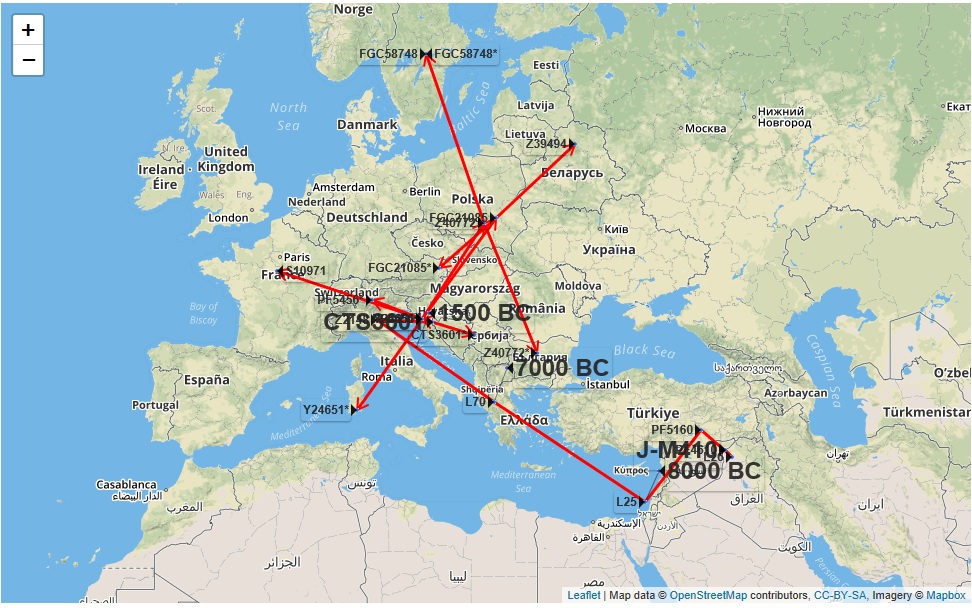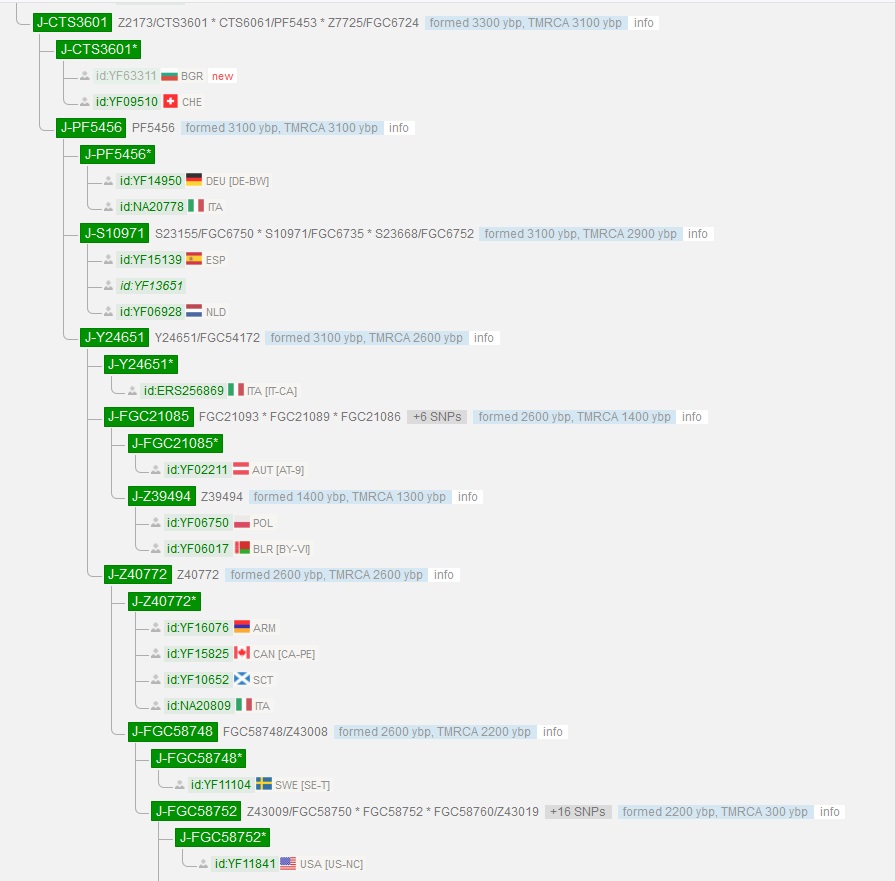I think this haplogroup is very interesting because it contains one branch (Z40772) that has Scots, Italians, Swedes and Armenians descended from a man who lived 600 BC.

I don't think it is yet clear whether the Late Bronze Age origin of CTS3601 is Central Europe or Italy. Perhaps participation in population movements relating to the Bronze Age Collapse, Celtic expansion and Roman Empire have obscured an otherwise simpler distribution.
In this case a man living in 1100 BC had, before the year 600 BC, six different lineages. Five are represented on YFull by the following living descendants: a Bulgarian, Swiss, German (BW), Italian, Spanish-Dutch, and intrepid Y24651 from Italy to England, Central and Eastern Europe and Armenia.
The fact that Y24651 sired so many offspring in 600 BC more closely matches the timing of the Celtic expansion than the Romans. However unless the Armenian descends from a Galatian Celt who had migrated to Turkey (this seems a stretch), a Roman Empire-mediated migration to Armenia seems more plausible.
We will have more information to work with when:
1. Additional samples are found under FGC21085 that will point to its origins as Eastern or Central European.
2. If the Sardinian sample's ancestors can be determined to have migrated to Sardinia with Ligurians vs Romans or later
3. More is known of the Armenian sample's paternal origins
4. An Old World paternal origin can be ascribed to the American samples at FGC58752

I am the swiss men you can see on Yfull, Thank you for this post !
Hi. An ancient sample found in Rome was confirmed as Z40772. It was found on a tomb located on San Marcellino & Pietro Catacombs, on ancient Via Labicana, south east Rome. The analysis of the individual, named R136, was published on Science some days ago. Scientists were lead by M. Antonio of Stanford Univesity and the SNP Analysis was made by Anthony Lizza.
Thanks Juan. I plan to add all these samples to PhyloGeographer by the update, which will follow YFull’s next update.
Thanks to you. Best regards
My brother has tested as J-Z40772 on FTDNA and has no matches. I am happy to have found the information on this page. Maybe there are others out there, too. Our surname is Scottish but I’ve been told by the folks at FTDNA that our male line isn’t Scottish and our surname was most likely adopted at some point. The hunt continues!
Your lineage J-Z40772 is very geographically diverse.
I think Roman mediated migration is one possible explanation for how some men are spread between Armenia and Scotland from a common ancestor who lived around 600 BC.
https://www.yfull.com/tree/J-Z40772/
You would need to find another closer relative to do NGS testing to get a better idea of how long your ancestors have been living in Scotland. Though, at first glance, it looks like prior to 600 BC may be unlikely. Your haplogroup researchers will know better, your haplogroup is not in my area of expertise despite we are both J2.
Dispersion during the Roman Empire is almost certainly the reason for J-Z40772 distribution today. Soldier, merchant, people of these professions mostly moved from province to province. The Scots in this branch are originally from places near Hadrian’s Wall, which may or may not be an indicator. A similar case is with me, i live very close to Danube Limes. Greet your brother on my behalf.
Hi Hunter. New samples were added to this clade. Two Samples from Turkey as basal, another sample from Cyprus and another greek sample under Z40772. Also is relevant to underline that a sample from Italy is basal to Z435. So I think, as the Finocchio paper from 2018 states, that CTS3601 could be Greek (perhaps Greco-Anatolian). PF5456 could be Italian, we can see a basal Tuscan sample under S11348, and all the other clades expanden during roman times, almost everywhere.
What do you think?
Best Reagards
Juan
Both up- and downstream this branch you’ll find that the majority of people are Jewish.
Most likely to me is that the non-Jewish people under this branch are descendants of conversed Jews. This easily explains the spreading across Europe, as Jews and there descendants have been living across Europe for over 2000 years.
It also explains the density of this dna in areas such as German Rhineland and Southern Italy, where once were large Jewish communities. Scottish and Dutch/Belgians where largely involved in Cloth and wool trade in the middle ages. A trade in which a lot off Jews (and likely also their conversed descendants) where active. This could explain the Scottisch and Dutch/Belgian clusters. There were both Scottish communities in the Low countries as there were Flemish in Scotland, hence the Scottisch surname Fleming.
Thanks for your Reply Jeronimus. We should wait for ancient DNA to have a clearer picture. I do think an Anatolic-Greek-Roman path is much more possible ( with different religions and cultural heritage, including Pagans, Jewish and Cristians of course). I Think romans expanded it all over their empire. Indeed the oldest sample we have under this clade was found in Rome. It was buried on the Sati Pietro e Marcellino catacomb on the V century AC. His Autosomal was define by researchers as Southern Italian/Greek. The other ancient samples just one SNP on top of this clade, under Z2148, are a Visigoth, in Northern Spain and a Viking in Sweden. Regarding CTS3601, the deepest scientific paper that includes this clade, was made by Andrea Finocchio et al. on 2018. ”A finely resolved phylogeny of Y chromosome Hg J illuminates the processes of Phoenician and Greek colonizations in the Mediterranean”, their hypothesis is that this clade was part of the Greek expansion on the VIII Century BC, to southern Italy, they give solid scientific proves to this statement. Let’s wait and see. Regards
Hi, I’m from Turkey. I didn’t do snp test but my y dna matches and nevgen says I’m CTS3601. There is a rare think my heritage is kurdish. But in my village, our tombstones exactly like ancient meditarrean tombstones. I’m confused.
I haven’t looked at this subclade lately. There were a number of samples from the study on people from Turkey added to this haplogroup on YFull. Unfortunately we don’t know their ethnic or geographic backgrounds.
What part of Turkey are you from?
I’m from Central Anatolia (Sivas). But my tribe came from north iran (Khorasan). We are speaking Kurmanci and our religion is Muslim Alawites.
Hi, There is branch under CTS3601, L1021, that has some turkish/kurdish.
Hi, I’m from Serbia and I recently received the result of J-Z40772 from Yseq laboratory. The lowest branch has not yet been determined. I tested for BY195335, Z32138, Z41163, all negative. I guess i will form a separate branch. By the way, i am an ethnic Vlach and i speak the timok Romanian (also known as Vlach) language.
Hello,
Interesting result! I recently upgraded a man of Hellenized Vlach descent to WGS at YSEQ. He’s J2b-L283.
If you do Facebook you can join the J2 group there to find those interested in advancing the research into your lineage of J2a-L70
https://www.facebook.com/groups/2815030622094777
There is also a general J2 group – https://www.facebook.com/groups/j2.m172
best,
Hunter
J2b2-L283 is considered the original Illyrian haplogroup (along with R1b-L51 of course). So he is probably a Romanized Illyrian who has been Hellenized in recent times. Unfortunately, it has nothing to do with us who are J-Z40772.
Hello from Germany,
My J2a-L24 panel test at YSEQ showed the last position as Y-82443. The subclade above is haplogroup J-F15010, a subgroup of Z40772. J-F15010 lists a Swedish person from the 17th century.
My ancestors come from Silesia. There, they can be traced back to the 17th century, north of Breslau/now Wroclaw. It was an area settled by Slavs after the Great Migration, before the German eastern colonization began in this area in the 14th century. I would like to find out whether the people with my surname were Slavic “natives” or belonged to the German immigrants. A large concentration of my surname currently exists in southwest Germany, in a city called Kaiserslautern. I would like to find out whether these people are related to the identically named people from Silesia. How to classify the Swedish person with the same haplogroup is still a mystery to me. Best regards,
Manfred
Hi Manfred,
Sorry for the very late reply, my family just moved to the states and things have been busy. Your haplogroup J2a-Z40772 appears likely to have originated in Armenia around 700 BCE given that two lines that are almost that old are almost exclusively found there.
I completely understand your question regarding the deeper origin of a Silesian because my own maternal grandmother was born in Gliwice (then Gleiwitz), Upper Silesia.
I’ll email you regarding possible next steps to aid your research.
Best Regards,
Hunter